Malcolm and Tracy in Madeira
Monday 14th June 1999
Madeira (a long way off the coast, south west of Portugal).
Having decided to take this trip on Thursday night, booking it on Saturday and leaving
on Monday, we had little choice of the departure airport so Monday morning found us making
the long haul to Luton.
It took only another 3 hours to get to Funchal airport on the island of Madeira. Our
late booking was with Thomson's Holidays so we were subject to the unfamiliar shepherding
by a Thomson's rep and were whisked off to our 4 star hotel in the 'Hotel District' of
Funchal. This is not our preferred choice of accommodation being far to polished for our
tastes but we were not about to complain. |
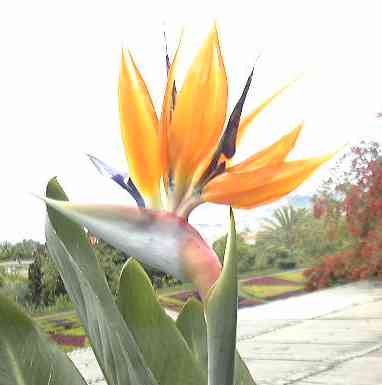 |
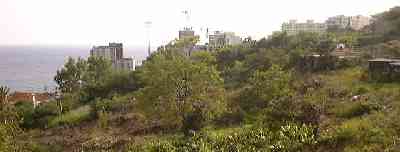 |
Outside our window the sea is a short walk away whilst all about us more hotels are
sprouting like concrete carbuncles in the quiet farming land (oops, I suppose we are
helping to fuel this frenzy). On the other side of the wall to our marbled hotel a couple
of very small dwelling are surrounded by makeshift extensions and small banana
plantations. |
Walking along the road in search of our evening meal we are put off by restaurateurs
trying to lure us in and head off down to the sea. We come across a small quiet restaurant
overlooking the rocky beach and sit on the little terrace listening to the waves breaking
gently on the rocks as we eat wonderful meals of octopus and tuna. What the restaurant
lacked in aesthetics it made up for in the quality of the grub. The sun set over the
Atlantic as we finished our meal and drank our wine. After a short walk along the sea
front we turned in for the night.
Tuesday 15th June 1999
| The next morning we rushed our extravagant continental style breakfast to meet up with
the Thomson rep again. This turned out to be a repetition of the following afternoons talk
on the bus but sweetened by a glass of Bolo Madeira. Walking into town we visited the
'Sta Catrina Park' and Municipal gardens. It would seem that the Madeirans are as keen on
gardening as the British but then there is much British influence here as we find out
later when we visited the Blandy's wine lodge. |
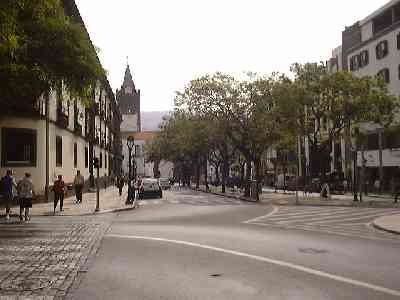 |
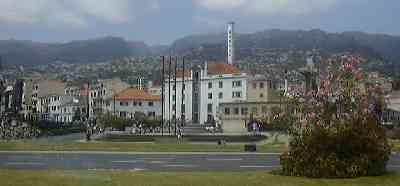 |
Our tums tell us it is time for lunch so we find a small cafe where a simple omelet
turns out to be a full blown meal. We haul our stomachs out of the cafe and head for the
market which is full of flowers on the ground floor, fruit on the first and fish out the
back. Here we see the Espada (Black Scabbard) fish that we heard about before. It is eel
like at one and a half times the length of an arm, black and features large saucer like
eyes and a huge set of jaws inset with sharp teeth. It's a scary creature so we decide to
eat it later. |
| A short walk away is the sea front where we walk back towards our hotel. This is not a
seaside town, probably because of the rocky shore but the place has a certain charm to it.
The whole of the island seems to be mountain stretching from the shore up into the clouds.
All around the town the slopes are covered with terra-cotta tiles topping the whitewashed
walls of private houses. Further up, the green slopes disappear into the clouds. All
about, tropical plants add many splashes of colour to the streets. |
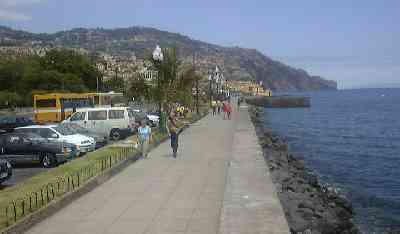 |
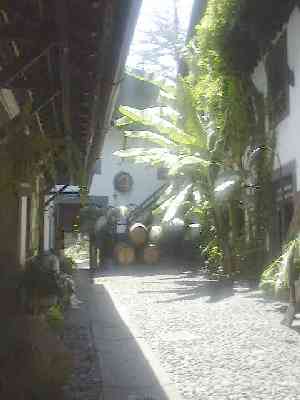 |
The Blandy's wine lodge resulted from the merging of four Madeira wineries all of them
started by British families. We went on the tour of the wine lodge and discovered that
Madeira wine obtained its current form when it was found (by accident) that the wine
lasted better when subjected to heat whilst in the oak casks. This, combined with the
fortification with brandy or wine alcohol gave it longevity for transport purposes and
other desirable attributes such as alcoholic strength, full body and colour. The tour was
well worth the 500 escudos if only for the glasses of Madeira wine both before and after. |
Following a swim in the hotel pool we dined on bread, cheese, ham, olives and wine
which compensated somewhat for our large lunch. Downstairs a Lambada show was getting
under way so we took our glasses of wine and went off to see. The barman complained that
we had to buy something from his bar to sit in his area so we forked out enough for a
bottle of Madeira which somehow fitted into two small glasses, just in time to see the
show finish. Bugger!
Wednesday 16th June 1999
| Just down the road we found the Jardim Orquidea (Orchid Garden) which provided another
welcome retreat from the noisy city. Here we learned just how difficult it is to cultivate
orchids with sterile and temperature controlled conditions required to germinate the
minute seeds. And it was all worth it for they produced a wonderful display. |
 |
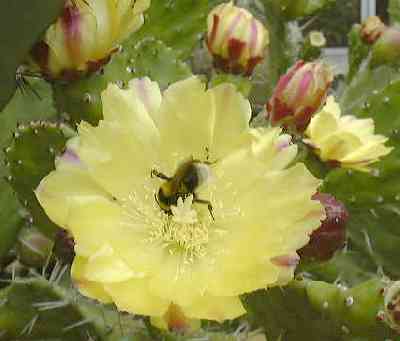 |
There seems to be no flat land in this city. Almost so that some people can walk out
of their back door onto their neighbors roof. Despite the difficulties of building on
steep slopes they seem to have made a good job of it and even maintain their dwellings in
good condition which is unusual for southern European countries. All in all the
inhabitants of Funchal seem to be quite well off which is perhaps surprising considering
that the main industry is tourism (followed by Madeira wine). It may have something to do
with all the Deuchmarks that seem to be flooding into the country. Strangely enough all
the cars that we have seen so far are almost all recent models. I wonder what happens to
all the old cars. Mobile phones seem to be as popular here as back home. |
For dinner we revisited the restaurant 'Tora De Polvo' where we ate the first night. We
took our favoured table on the balcony overlooking the sea so that we again could listen
to the waves breaking on the rocky beach. We both decide to try out the famed espada, the
long black eel like fish with huge eyes and lots of teeth. Fortunately it does not look
much like this on the plate but tastes strangely like cod, especially considering that it
came in batter and with chips (albeit garlic chips). All washed down with a bottle of
Portuguese red wine, excellent.
Thursday 22nd June. Out of Funchal.
Today we walked a different route into the centre taking in the Quinta Magnolia (public
gardens with swimming, tennis and squash) and some of the back streets. They don't seem
cramped for space here with most of the residences being detached houses with gardens.
Many of the houses are quite large and surrounded by gardens which often contain small
plantations of bananas, vines and sometimes sugar cane. There are few flat blocks outside
the centre of town and heaps of hotels.
| We make it to the bus stop by 11:45 to catch the 138 bus to Santana on the north side
of the island. Santana is only about 14 miles away but the bus is scheduled to take 2.5
hours to get there and we soon see why as we start to climb up the steep winding roads. It
would have been fun to ascend into the clouds but today the sky's are clear and we can see
the clouds way out over the ocean. Many of the indoor plants we buy from the garden centre
seem to grow here in the wild. Of the ones I can name (or think I can) are Agapanthus,
crocosmia, ‘bird of paradise’, lilies including Calla lily, many geraniums and
cactus, orchids and a great many other that I can't name. |
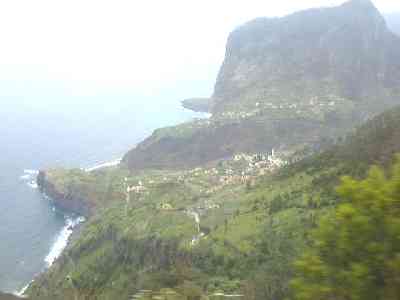 |
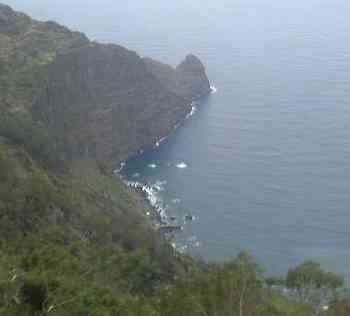 |
The whole island seems to be covered in splashes of colour. The bus takes us through
forests of pine and eucalyptus (from Australia) with magnificent views of rocky peaks and
deep valleys. There are a few farming settlements inland with their crops clinging to the
sides of the mountain in little terraces with sub terraces within them to top the water
just flowing down the hill. It looks like a tough type of farming with most machinery
impractical on the slopes it's all down to manual toil. |
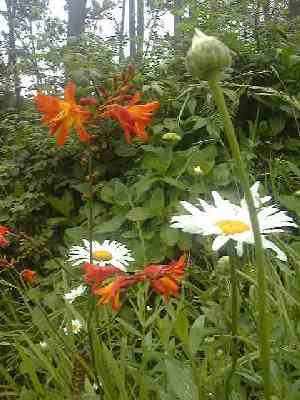 |
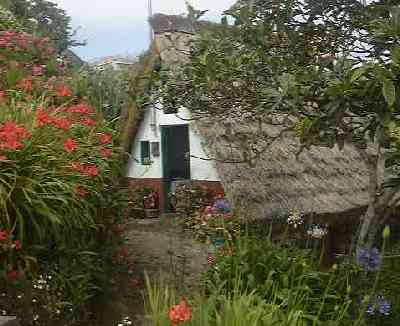 Santana
turned out to be a nice quiet little town in much the same style as the outskirts of
Funchal. There is a pleasant shortage of cars with those few that are around all being
new. We eat our lunch of bread and cheese in a little garden with a fountain near the
centre of town and head off to find the shore. We are soon side-tracked by what appears to
be one of the levadas that run all around the island. These are little concrete channels,
perhaps only one foot wide and deep, that carry water from the mountains springs to
irrigate the farm land and perhaps even for household water supplies. We have heard that
the paths that run by the side make good walking tracks so we head off down it to see what
will happen. The path takes us through fields of sugar cane, vines, potatoes, strawberries
and past farming houses before leading back to the road. Santana
turned out to be a nice quiet little town in much the same style as the outskirts of
Funchal. There is a pleasant shortage of cars with those few that are around all being
new. We eat our lunch of bread and cheese in a little garden with a fountain near the
centre of town and head off to find the shore. We are soon side-tracked by what appears to
be one of the levadas that run all around the island. These are little concrete channels,
perhaps only one foot wide and deep, that carry water from the mountains springs to
irrigate the farm land and perhaps even for household water supplies. We have heard that
the paths that run by the side make good walking tracks so we head off down it to see what
will happen. The path takes us through fields of sugar cane, vines, potatoes, strawberries
and past farming houses before leading back to the road. |
| There is a derelict cottage at the crossroads of the old style which looks like a
thatched cottage but without the walls. The thatch goes right down to the ground making a
triangular little house with a wide downstairs room and a very small upstairs room. There
are a few of these houses still in use but most have been replaced by the larger modern
buildings with white vertical walls and sloping roofs of terra-cotta tiles. |
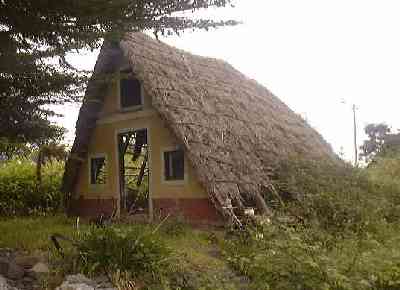 |
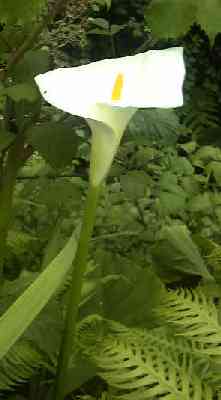 |
.jpg) We make
another attempt to reach the coast down a small track. Down here we meet few friendly old
farmers, one lady tries to tell us al about the plants growing in her field but she soon
gives up with a smile and a little giggle. The path seems to peter out at a large water
cistern full of croaking frogs and very little water. The frogs quickly hide with great
success in the thin layer of mud in the bottom. Meanwhile, the path seems to slope rapidly
down to what we suspect is a cliff. We make
another attempt to reach the coast down a small track. Down here we meet few friendly old
farmers, one lady tries to tell us al about the plants growing in her field but she soon
gives up with a smile and a little giggle. The path seems to peter out at a large water
cistern full of croaking frogs and very little water. The frogs quickly hide with great
success in the thin layer of mud in the bottom. Meanwhile, the path seems to slope rapidly
down to what we suspect is a cliff.Back in town we find a small hotel (Colmo) where we
decide to stay the night. This is a much nicer place than Funchal and we don't want to go
back. The second and last daily bus goes back to Funchal at 17:45 without us.
For dinner we try out the renowned 'espetada' which turns out to be kebab and chips. |
Friday 18th June 1999
.jpg) |
After breakfast we check out of the hotel, pick up some lunch and head off to find
some scenic walks. We take the high road this time to get the panoramic views and find
ourselves climbing very steep roads towards the mountains. There are very few cars on the
roads, mostly Nissan Micras hired by tourists or open trucks that the farmers use to get
their produce to market. We stop to watch the people working the fields by hand and
channelling water from the levadas onto their fields and down the terraces to water the
crops. The only agricultural machinery we have seen so far is one tractor. |
Further up the road is lined with what looks like willow twigs tied into bundles and
leant against frames by the side of the road. There are so many that it looks like fences
between the road and field. Even further up people are soaking the twigs to get the bark
off and then tying them into bundles. Perhaps they are used for making baskets but we do
not see any evidence of this.
| The road continues to climb steeply up the mountain and we follow it until a levada
crosses its path and we head down this for an easier walk. The path follows the contour of
the mountain and provides numerous vistas out across the forest of pine and eucalyptus
trees and out to the sea. It is not often that the only sounds about are those of the
birds singing, flies buzzing, water gurgling and wind rustling the trees. Even the sky is
clear blue with white clouds, not like the murky brown sky we get back home. Further on
the path is closed due to levada works'. They seem to be laying a water pipe next to the
levada (?) so we cannot continue that way. We stop for a snack and to absorb the relaxing
atmosphere before proceeding along the levada on the other side of the road. This also
peters out so we head into the forest where the smells of eucalyptus and pine are strong. |
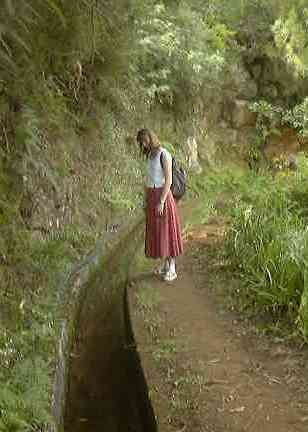 |
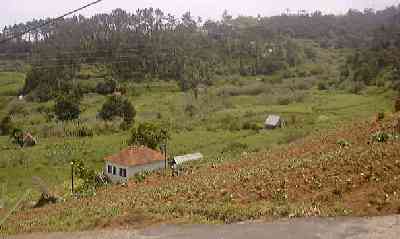 |
We find a delightful little spot under a tree with a wonderful view to stop and eat
lunch.
All too soon we have found our way back into town and stop for a coffee in one of the
many un-populated cafes dotted across the hillside. Our 17:30 bus leaves soon so we make
our way to meet it. |
.jpg) |
| The bus makes its way slowly back along the winding roads into the mountains. Houses
and crops cling unbelievably to the steep mountain slopes. Soon we enter the clouds that
have built up around the mountain tops and then break through to the sunshine above. As
the views above the clouds stretch out magnificently behind us the bus falters and stops.
Everyone piles out while the driver runs back down the hill to get help from the last
settlement we passed through. We sat on the wall by the road watching the clouds wash
round the mountain tops like the tides of the sea on the shore for about an hour until
another bus came along to rescue us. The rest of the journey is scenic but uneventful. |
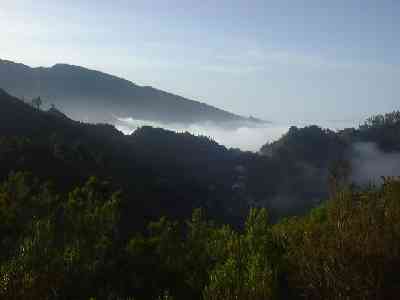 |
Saturday 19th June 1999. The lazy day
| The whole morning at the pool, staying in the shade to safeguard our red bits.
Afternoon coffee at our favourite coffee house, strangely named 'tea time' and off to
Camara de Lobos, a couple of clicks west along the coast, for dinner. A slightly quieter
and poorer version of Funchal, this is where Winston Churchill used to go to paint and not
to miss out on a capital opportunity there is a restaurant named 'The Winston Churchill'.
Down by the pebbly beach (and we are talking megga pebbles) there is a small locals bar
where we stop for a beer or three (no Bacardi) and watch the sun go down over the children
playing in the sea. A cheese and ham toastie at a cafe up the cliff and its on the next
bus back to Funchal. |
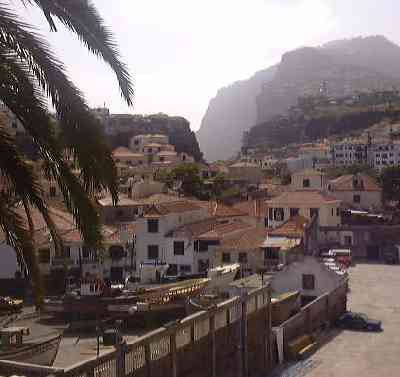 |
Sunday 20th June 1999
| We stepped into the 15th century as we boarded the Santa Maria at the marina for it is
a fully functional replica of the galleon that Christopher Columbus sailed round the
world. This version, built in Camara de Lobos, has the additions of a bar, toilet and
diesel engine to avoid those 'becalmed' moments. |
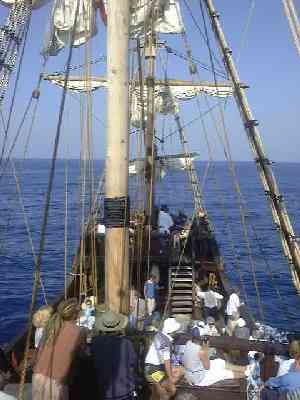 |
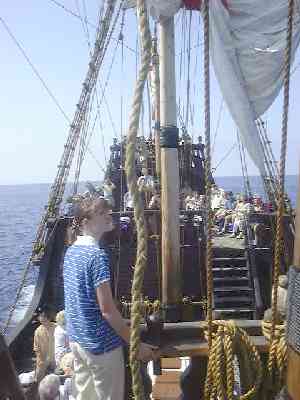 |
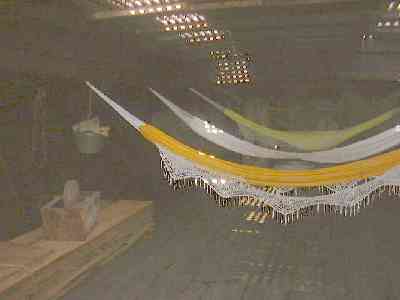 |
With 5 appropriately dressed crew and about 40 passengers we motored easily out of the
marina and along the coast to Camara de Lobos. It is hard to imagine setting sail for such
epic voyages on a ship only 22m long by 7m wide. The crew must have had lots of patience
or lots of rum for calm days like today when the wind hardly flapped the sails. Below the
main deck were only three hammocks and a few examples of timber and tools. There was a
sheltered area in the bow and a large cabin in the stern which housed the bar and tables.
Above this was another cabin probably used by old Chris. |
| It is an amasing (that it ever traveled so far) ship and a wonderful opportunity to
sail in her and to see the craftsmanship that went into building the replica in what looks
like minute detail. I can't imagine traveling very far before getting either bored out of
my mind whilst becalmed or scared to death in a storm. With a draft of 2.74m and a total
height of abut 10m it is surprising it ever stays upright even without the masts, sails
and a bit of wind. When they did put the sails up, the gentle breeze made it sway around
quite allot and we did not even get anywhere. The crew served Madeira wine and cake just
before we went back to the marina. |
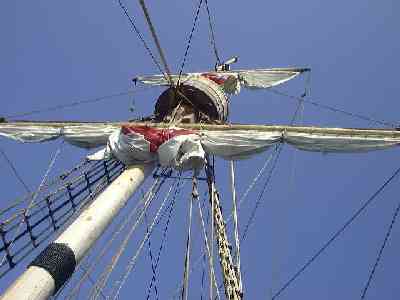 |
After a quick visit to our favourite coffee house we took a dip in the ocean where our
mask and snorkel revealed a few tropical fish.
For the evening, we nipped down to the Casino Park Hotel where we tucked into a four
course meal and watched a rather good cabaret.
Monday 21st June 1999. Last day.
| Not wanting to miss out on anything we used up our last few hours on the island by
visiting the Tropical Palace Gardens (Jardim) at Monte. Having been a private house and
then a hotel, it is now a rather nice gardens. I was particularly interested to see the
Madeiran endemic section because many plants on the island seem to have been imported by
the early settlers. Considering the display it would seem that the extent of the original
flora was quite limited with only a few laurels, cedars, ferns and the Madeiran daisy.
Thankfully the imported plants have added great splashes of colour to the island. The
gardens also had large sections of Japanese appearance including many coy carp ponds and
Japanese statues, pagodas and bridges. |
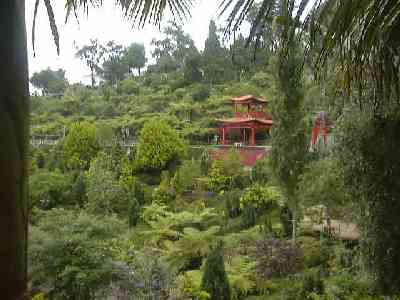 |
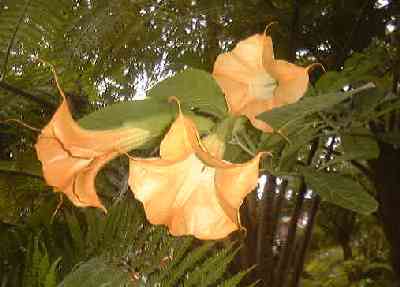 |
We skipped the 'traditional toboggan' ride where a wicker chair on greased wooden
runners is skidded down the hill. |
All in all, Madeira is a lovely place to visit although if we came again we would book
the flight only and stay only a couple of days in Funchal. The rest of the island seems
much more appealing than the noisy, smelly city full of hotel developments and many other
tourists.
Travelogues by Malcolm Weller







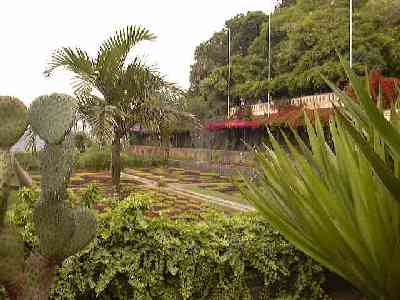
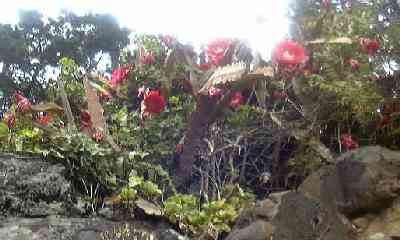

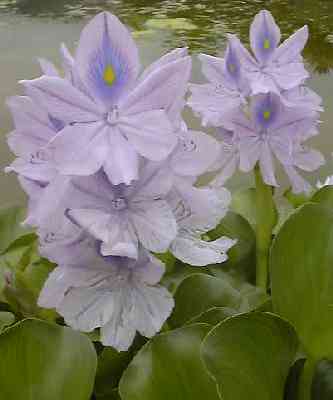
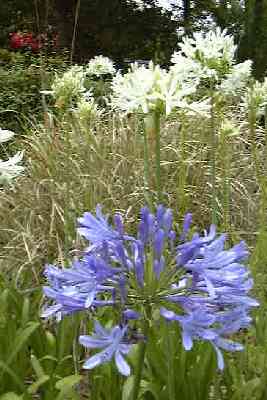





 Santana
turned out to be a nice quiet little town in much the same style as the outskirts of
Funchal. There is a pleasant shortage of cars with those few that are around all being
new. We eat our lunch of bread and cheese in a little garden with a fountain near the
centre of town and head off to find the shore. We are soon side-tracked by what appears to
be one of the levadas that run all around the island. These are little concrete channels,
perhaps only one foot wide and deep, that carry water from the mountains springs to
irrigate the farm land and perhaps even for household water supplies. We have heard that
the paths that run by the side make good walking tracks so we head off down it to see what
will happen. The path takes us through fields of sugar cane, vines, potatoes, strawberries
and past farming houses before leading back to the road.
Santana
turned out to be a nice quiet little town in much the same style as the outskirts of
Funchal. There is a pleasant shortage of cars with those few that are around all being
new. We eat our lunch of bread and cheese in a little garden with a fountain near the
centre of town and head off to find the shore. We are soon side-tracked by what appears to
be one of the levadas that run all around the island. These are little concrete channels,
perhaps only one foot wide and deep, that carry water from the mountains springs to
irrigate the farm land and perhaps even for household water supplies. We have heard that
the paths that run by the side make good walking tracks so we head off down it to see what
will happen. The path takes us through fields of sugar cane, vines, potatoes, strawberries
and past farming houses before leading back to the road. 

.jpg) We make
another attempt to reach the coast down a small track. Down here we meet few friendly old
farmers, one lady tries to tell us al about the plants growing in her field but she soon
gives up with a smile and a little giggle. The path seems to peter out at a large water
cistern full of croaking frogs and very little water. The frogs quickly hide with great
success in the thin layer of mud in the bottom. Meanwhile, the path seems to slope rapidly
down to what we suspect is a cliff.
We make
another attempt to reach the coast down a small track. Down here we meet few friendly old
farmers, one lady tries to tell us al about the plants growing in her field but she soon
gives up with a smile and a little giggle. The path seems to peter out at a large water
cistern full of croaking frogs and very little water. The frogs quickly hide with great
success in the thin layer of mud in the bottom. Meanwhile, the path seems to slope rapidly
down to what we suspect is a cliff..jpg)


.jpg)








